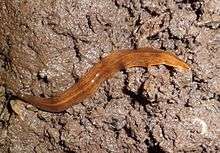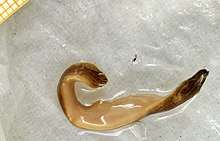Obama nungara
Obama nungara /ˈoʊbəmə/ is a species of land planarian in the family Geoplaninae. It is native to South America, but has been introduced in Europe.[1]
| Obama | |
|---|---|
 | |
| Obama | |
| Scientific classification | |
| Kingdom: | |
| Phylum: | |
| Class: | |
| Order: | |
| Suborder: | |
| Family: | |
| Subfamily: | |
| Genus: | |
| Species: | O. nungara |
| Binomial name | |
| Obama nungara Carbayo, Álvarez-Presas, Jones & Riutort, 2016 | |
| Synonyms | |
|
Obama marmorata (von Graff, 1899) sensu Lago-Barcia et al., 2015 | |
Description

Obama nungara is a medium-sized land planarian with a lanceolate body, being up to 70 millimetres (2.8 in) long. The background color of the dorsum varies from golden yellow to honey yellow and is covered by dark-brown to black spots and flecks aggregated in short and irregular longitudinal streaks, giving it a light to dark-brown marbled appearance. A fine line devoid of brown pigmentation usually runs lingitudinally along the middle of the dorsum, sometimes having a diffuse dark border formed by concentration of the brown pigmentation. In some specimens this line is also covered by pigmentation and is almost unnoticeable. The ventral side has a uniform cream to grey-white color.[2]

As in most species of the genus Obama, O. nungara has hundreds of eyes distributed along the body. They form a single row around the anterior tip and after the first millimeters they become pluriserial, spreading to the dorsal surface and occupying about one third of the body width on either side.[2] The dorsal eyes are surrounded by clear halos (areas devoid of pigmentation) which may be perceived as a set of small whitish dots under close inspection or under a stereo microscope.
The general color pattern of O. nungara is very similar to that of Obama marmorata, a species with which it lives in sympatry in some areas in southern Brazil. As a result, O. nungara was initially mistakenly identified as O. marmorata.[3]
Etymology
The specific epithet nungara comes from Tupi, meaning similar, alike, and refers to the resemblance of O. nungara to O. marmorata.[2]
Distribution and ecology
Obama nungara is native from South America. Populations in the two southernmost Brazilian states, Santa Catarina and Rio Grande do Sul are most certainly native. The species is also found in Argentina, where it may be native or introduced.[3] It is very common in human-disturbed areas, especially gardens and parks.
Obama as an invader in Europe


Since 2008, a large land planarian has been found in several localities in Europe, including Guernsey, Great Britain, France, Spain, Italy[1] and, more recently, Belgium.[4] It was identified as possibly of Neotropical origin and belonging to the genus Obama, but its true identity was not resolved at first.[1] In France, where it seems to be particularly common, it has been nicknamed marron plate (French for flat brown).[5][6]
A study published in 2015[3] identified the species as Obama marmorata based on the morphological redescription of this species by Froehlich.[7] However, a year later, a new study using morphological and molecular analyses including material of Obama marmorata from the type-locality of the species concluded that the invasive species found in Europe, which is also common in southern Brazil and northern Argentina, is a new species, and it was named Obama nungara.[2]
In a study published in 2020, Obama nungara was recorded from Italy, Switzerland, and 72 of the 96 Departments of Metropolitan France. The species was especially abundant along the Atlantic coast, from the Spanish border to Brittany, and along the Mediterranean coast, from the Spanish border to the Italian border. More than half of the records were from an altitude below 50 m, and no record was from above 500 m; mountainous regions such as the Alps, Pyrenees and Massif Central were not invaded. Local abundance was considered impressive, with hundreds of specimens found in a small garden.[8] On the basis of a molecular analysis, the study also concluded that the population which has invaded several countries in Europe came from Argentina, not Brazil.[8]
Diet
Obama has been reported to feed on earthworms and land snails. As a result, it may pose a threat to native populations of these groups in Europe.[2][5][8]
In southern Brazil, O. nungara (identified as O. marmorata) was reported to feed on the invasive land planarian Endeavouria septemlineata.[9]
References
- Álvarez-Presas, Marta; Mateos, Eduardo; Tudó, Àngels; Jones, Hugh; Riutort, Marta (2014). "Diversity of introduced terrestrial flatworms in the Iberian Peninsula: a cautionary tale". PeerJ. 2: e430. doi:10.7717/peerj.430. ISSN 2167-8359. PMC 4060057. PMID 24949245.

- Carbayo, Fernando; Álvarez-Presas, Marta; Jones, Hugh D.; Riutort, Marta (2016). "The true identity of Obama (Platyhelminthes: Geoplanidae) flatworm spreading across Europe". Zoological Journal of the Linnean Society. 177 (1): 5–28. doi:10.1111/zoj.12358. ISSN 0024-4082.
- Lago-Barcia, Domingo; Fernández-Álvarez, Fernando A.; Negrete, Lisandro; Brusa, Francisco; Damborenea, Cristina; Grande, Cristina; Noreña, Carolina (2015). "Morphology and DNA barcodes reveal the presence of the non-native land planarian Obama marmorata (Platyhelminthes : Geoplanidae) in Europe". Invertebrate Systematics. 29 (1): 12. doi:10.1071/IS14033. ISSN 1445-5226.
- Soors, Jan; Van den Neucker, Tom; Halfmaerten, David; Neyrinck, Sabrina; De Baere, Marc (2019). "On the presence of the invasive planarian Obama (Carbayo, Álvarez-Presas, Jones & Riutort, 2016) (Platyhelminthes: Geoplanidae) in an urban area in Belgium". Belgian Journal of Zoology. 149 (1). doi:10.26496/bjz.2019.29. ISSN 2295-0451.

- Justine, Jean-Lou; Thévenot, Jessica; Winsor, Leigh (2014). "Les sept plathelminthes invasifs introduits en France". Phytoma (in French). 674: 28–32. doi:10.6084/m9.figshare.1447202.

- Justine, Jean-Lou. "Les espèces". Blog: Plathelminthes terrestres invasifs (in French). Access on 21 April 2016.
- Froehlich, Claudio G. (1959). "On Geoplanids from Brazil". Boletim da Faculdade de Filosofia, Ciências e Letras da Universidade de São Paulo, Série Zoologia. 22: 201–265.
- Justine, Jean-Lou; Winsor, Leigh; Gey, Delphine; Gros, Pierre; Thévenot, Jessica (2020). "Obama chez moi! The invasion of metropolitan France by the land planarian Obama nungara (Platyhelminthes, Geoplanidae)". PeerJ. 8: e8385. doi:10.7717/peerj.8385. ISSN 2167-8359.

- Boll, Piter K.; Rossi, Ilana; Amaral, Silvana V.; Leal-Zanchet, Ana (2015). "A taste for exotic food: Neotropical land planarians feeding on an invasive flatworm". PeerJ. 3: e1307. doi:10.7717/peerj.1307. ISSN 2167-8359. PMC 4614845. PMID 26500817.

External links
- Jean-Lou Justine; Leigh Winsor (2020). "How a flatworm from Argentina jumped the Atlantic and invaded France". The Conversation (France). Figshare. doi:10.6084/m9.figshare.11878110.v1. Retrieved 2020-02-26.

- Piter Kehoma Boll. "Obama invades Europe: "Yes, we can!"". Earthling Nature. Retrieved 2017-03-22.

- Jean-Lou Justine (2017). "Avez-vous vu Obama dans votre jardin ? [Have you seen Obama in your garden?]". The Conversation (France). Figshare. doi:10.6084/m9.figshare.4750810.v1. Retrieved 2017-03-22.
